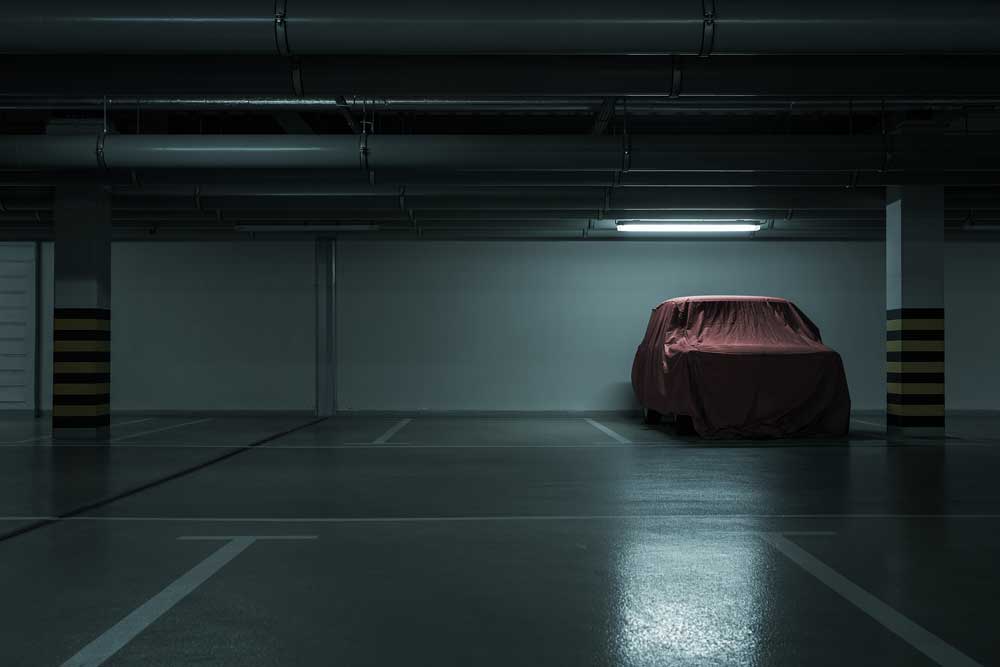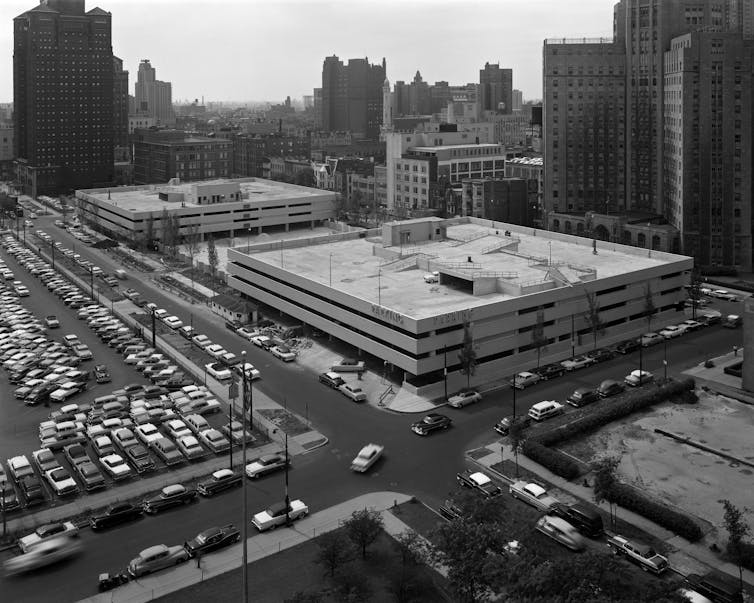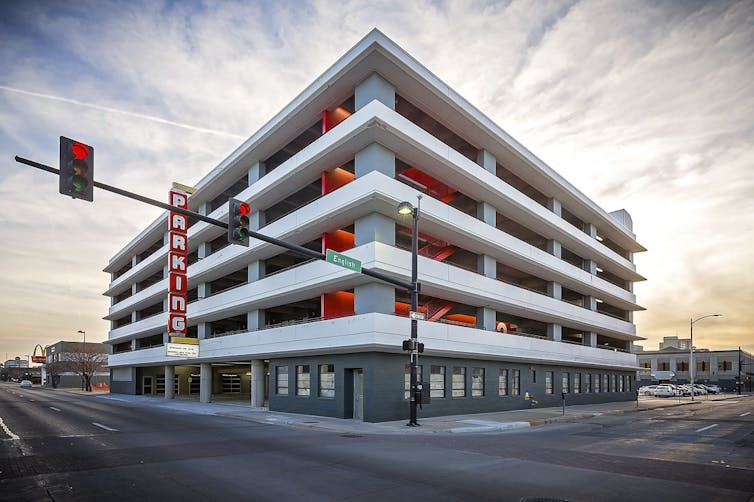
By Kevin J. Krizek and John Hersey
For the past century, the public and private sector appear to have agreed on one thing: the more parking, the better.
As a result, cities were built up in ways that devoted valuable space to storing cars, did little to accommodate people who don’t own cars and forced developers to build expensive parking structures that increased the cost of living.
Two assumptions undergird urban parking policy: Without convenient parking, car owners would be reluctant to patronize businesses; and absent a dedicated parking spot for their vehicle, they’d be less likely to rent and buy homes. Because parcels of urban land are usually small and pricey, developers will build multistory garages. And so today, a glut of these bulky concrete boxes clutter America’s densely populated cities.
We have been studying urban development and parking for decades. The car’s grip over city planning has been difficult to dislodge, despite a host of costs to the environment and to the quality of life for many city dwellers.
But we see signs that that’s finally starting to change.
A relic of the car craze
As car ownership exploded in the first half of the 20th century, municipalities started to mandate a minimum number of parking spaces whenever new stores or apartment complexes were built.
Many of these regulations continue to bluntly guide development.
For example, Boulder, Colorado, still requires one parking space per apartment, one spot for every three restaurant seats and one spot for every 175 square feet of retail space. Your community’s zoning regulations are likely all too similar.
Yet parking garages and parking lots end up using precious land to house cars instead of people at a time when cities are confronted with a severe housing shortage and skyrocketing housing costs. Only 20% of homes for sale are affordable to people making average incomes.

Chicago History Museum/Getty Images
A 2016 study found that it cost roughly US$24,000 to $34,000 to build every single new parking space in a garage – an amount that has surely grown. Developers typically pass on this expense to renters or buyers.
Parking requirements are a particular burden at many affordable housing developments, where low-income residents are less likely to own cars. Nonetheless, because of these requirements, they receive and inadvertently pay for parking all the same.
Parking garages are monuments to outdated beliefs about what makes cities thrive. They increasingly cater to cars that are rarely used – the typical car is parked 95% of the time – and ultimately facilitate urban sclerosis.
Do U.S. cities still need to require the construction of parking spots for new residential and retail projects? Aren’t developers, designers and investors better positioned to worry about these issues for customers, clients or tenants?
Regulation reform
Thankfully, in some parts of the country, a course correction is already underway.
City planners, developers and designers now have new guidelines that make parking spots less of a priority and take into account all of the new ways people get around.
Dozens of cities, including Denver and Minneapolis – along with the entire state of California – are reforming parking requirements, promoting transportation alternatives and amending regulations for new construction.
Developers are also finding ways to accommodate growing numbers of residents who are forgoing car ownership altogether.
- At The Civic, a condominium complex in Portland, Oregon, builders swapped dedicated parking for 24 households for car-share memberships.
- At the Casa Arbella Apartments in the Fruitvale neighborhood of Oakland, California, residents receive $150 for transport services and shared bikes.
- Mile High Development leased 120 spaces in an adjacent underutilized public garage for Denver’s Sheridan Station Apartments, improving the financial solvency of the income-restricted project and passing the savings on to tenants.
- 1213 Walnut, an apartment complex in Philadelphia, unbundles apartment rents from parking spaces to allow residents to pay for only what they need.
- Even in Tempe, Arizona – a city that’s a poster child for car-centric urban sprawl – a development called Culdesac is being built as a car-free community. As a stipulation of living in the 17-acre development, which includes a mix of stores and apartments, residents must agree to never park a car on site.
Mushroom farms and food markets
But what to do with existing garages that suck up choice real estate?
Demolishing these garages requires additional energy, emissions and money. Garages’ sloped ramps and heavy concrete make adaptation challenging; there isn’t a natural transition to, say, loft apartments, like the high-ceilinged, big-windowed mills of the Northeast.
But these impediments haven’t stopped some developers from creatively repurposing existing garages.
For example, in Wichita, Kansas, Bokeh Development retrofitted a mid-20th-century garage into a 44-unit apartment building. In Denver, developers of the Denizen Apartments have built ground-floor parking designed to be easily converted to stores or apartments if cars fall out of favor.

Shelden Architecture
Other garages support urban agriculture; in Paris, one garage was recently converted to an urban mushroom farm. The open-air top decks of garages have hosted food trucks and food festivals, served as concert venues and operated as sites for solar panels.
These shifts have been spurred, in part, by changes to the way people get around cities, as well as changes to street design. For those who can afford them, ride-hailing services like Uber and Lyft can alleviate the need to own and park personal vehicles. Effective “mobility as a service” is around the corner in most cities, allowing residents to use a single app to connect to an array of transportation options. Electric bicycles and scooters have also expanded the suite of mobility options for city dwellers in a way that regular bikes have struggled to do for generations.
In the coming years, we believe that urban life will rely less and less on providing adequate storage for cars, and the cities of the future will eagerly embrace making urban neighborhoods more inclusive, pedestrian-oriented and climate friendly.
Space in cities is precious. The more human-oriented it can be, the better.
![]()
Kevin J. Krizek is Professor of Environmental Design at the University of Colorado Boulder. John Hersey is a Teaching Assistant Professor of Environmental Design at the University of Colorado Boulder.





























Jim says
Well, this seems to be solution in search of a problem.
I guess we can get rid of parking structures after we get rid of cars. Is that something that is on the horizon and I’ve just missed it?
If you’ve ever been in any city, parking is usually hard to come by. For instance, if you visit St. Augustine, they have a nice parking structure near the tourist district that is usually nearly full of cars. Try to find parking in that general area without that structure. And when there is a parking structure attached to an apartment building, it makes sense to provide parking spaces for the people living there.
I think there are many more pressing issues confronting the world other than parking structures. But when we get to the point that all those other issues are addressed, I’ll gladly jump on the band wagon!
Cid says
Written and thought of only by a liberal. Makes no sense and there’s no truth.
Ben Hogarth says
Cid, tell me you didn’t read the article without telling me. I guess this “no/low-effort” sort of retort is to be expected from a “conservative.”
FlaglerLive once again does its homework and adequately addresses the issue for urban planners looking to address two problems with one solution. There are creative solutions “out there” – but don’t expect communities that are prioritizing religious ceremony in public meetings and anti-progressive rhetoric to come up with any themselves. So that pretty much leaves cities like Palm Coast out.
Pogo says
@FlaglerLive
You can lead a horse to water. And a horse will do the natural and sensible thing: is the water safe and/or potable? Oh, good! I’ll have some.
People, as usual, are a whole different story. Rely on them to misunderstand why they were led there: lie to others about the reason and purpose, pee in the water — then bottle the water and sell it. Or a million other things typical of the “crown of creation.” After exhausting every possibility, e.g., drowning witches, price gouging the thirsty, labeling it “Holy Water” (has there ever been a time when some phony holy man wasn’t performing the miracle of filling tiny bottles with tap water and labeling it: from the river Jordan) etc.
But please, keep the light on anyway. Some of us see it and are grateful for the illumination.
And so it goes.
The ORIGINAL land of no turn signals says
Parking garages are hurting society?What’s next a push for a cashless America ? Make gas stoves illegal? Cow farts? electric cars for everyone even though it’s impossible to charge them all at the same time? Maybe you all can take turns with plug in hand.What a joke.
DaleL says
“electric cars for everyone even though it’s impossible to charge them all at the same time?” Makes no more sense than: gasoline cars for everyone even though it’s impossible to fuel them all at the same time?
Except on long trips, most electric car owners charge their cars at home, usually overnight. Home EV chargers (level 2) draw about the same amount of electricity as a clothes dryer or central AC unit.
The issue of this story is whether municipalities should mandate a minimum number of parking spaces whenever new stores or apartment complexes are built. On that issue, I think it is up to each locality to decide. One size does not fit all.
Joseph Debes says
I’m all for affordable housing, but in a beach “resort” community , I would think that could be difficult.
As a transplant from a major East Coast Metropolitan city, with a 45 minute (22 minute off rush hour) rush hour commute, I can tell you that even though there is a metro system available ( and I have used it several times) …my job schedule was unpredictable ( unexpectedly long days depending on the work “ crisis “). The metro schedule would not have worked for my daily commute. Especially when I had children with school activities and community appointments in different areas and along different transport routes, the metro combined with 2 buses would have meant taking the ENTIRE day off, rather than a few hours mid day, or time off early or late in the day. Of course I paid a premium $140/ month for the privilege of setting my own transport schedule ( that was for the garage, not a reserved spot). Parking on the street was both scarce and generally unsafe.
When I looked for local retirement housing in Flagler I literally spent 20 years looking for a home near the beach, with assigned parking space(s)..2 of them at my home, not just in a generally unassigned parking lot!
Flagler Beach has little (no?) public transportation, and expecting an Uber /taxi driver to be available at a moment’s notice is unpredictable. Those of you who have driven in the Flagler Beach area on weekends or any day in high season can tell you parking is EXTREMELY limited throughout the town even if you are willing to PAY.
As Flagler plans a new downtown hotel, which in addition to overnight guests, will undoubtedly have restaurants and events bringing non-overnight guests in cars. I HOPE there has been ample ON-SITE parking in the plans for this development, because simply driving 14 blocks to
Patronize downtown shops and restaurants is a chore NOW, without the hotel complex!
Perhaps in the plans, there should be a satellite parking area at the Edgar of town, with routine shuttle buses ( or VALET parking) for this new venture ( similar to what is done during Holiday fireworks displays and special events)